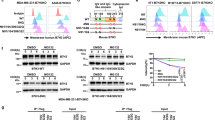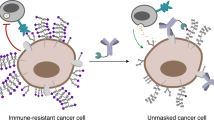Abstract
The glycosylation pattern of chCE7, an antineuroblastoma chimeric IgG1, was engineered in Chinese hamster ovary cells with tetracycline–regulated expression of β(1,4)–N–acetylglucosaminyltransferase III (GnTIII), a glycosyltransferase catalyzing formation of bisected oligosaccharides that have been implicated in antibody–dependent cellular cytotoxicity (ADCC). Measurement of the ADCC activity of chCE7 produced at different tetracycline levels showed an optimal range of GnTIII expression for maximal chCE7 in vitro ADCC activity, and this activity correlated with the level of constant region–associated, bisected complex oligosaccharides determined by matrix–assisted laser desorption/ionization time–of–flight mass spectrometry. The new optimized variants of chCE7 exhibit substantial ADCC activity and, hence, may be useful for treatment of neuroblastoma. The strategy presented here should be applicable to optimize the ADCC activity of other therapeutic IgGs.
This is a preview of subscription content, access via your institution
Access options
Subscribe to this journal
Receive 12 print issues and online access
$209.00 per year
only $17.42 per issue
Buy this article
- Purchase on SpringerLink
- Instant access to full article PDF
Prices may be subject to local taxes which are calculated during checkout





Similar content being viewed by others
References
Deo, Y.M., Graziano, R.F., Repp, R., and van de Winkel, J.G.J. 1997.Clinical significance of IgG Fc receptors and FcgR–directed immunotherapies. Immunol. Today 18:127– 135.
Dillman, R.O. 1997.Magic bullets at last! Finally—approval of a monoclonal antibody for the treatment of cancer! Cancer Biother. Radiopharm. 12:223–225.
Frost, J.D., Hank, J.A., Reaman, G.H., Frierdich, S., Seeger, R.C., Gan, J. et al. 1997.A phase I/IB trial of murine monoclonal anti–GD2 antibody 14. 2G2a plus interleukin–2 in children with refractory neuroblastoma. Cancer 80:317–333.
Surfus, J.E., Hank, J.A., Oosterwijk, E., Welt, S., Lindstrom, M.J., and Albertini, M.R. 1996.Anti–renal–cell carcinoma chimeric antibody G250 facilitates antibody–dependent cellular cytotoxicity with in vitro and in vivo interleukin–2–activated effectors. J. Immunother. 19:184– 191.
Wright, A. and Morrison, S.L. 1997.Effect of glycosylation on antibody function: implications for genetic engineering. Trends Biotechnol. 15:26– 31.
Wormald, M.R., Rudd, P.M., Harvey, D.J., Chang, S., Scragg, I.G., and Dwek, R.A. 1997.Variations in oligosaccharide–protein interactions in immunoglobulin G determine the site–specific glycosylation profiles and modulate the dynamic motion of the oligosaccharides. Biochemistry 36:1370–1380.
Lund, J., Takahashi, N., Pound, J.D., Goodall, M., Bentley, T., and Jefferis, R. 1996.Multiple interactions of IgG with its core oligosaccharide can modulate recognition by complement and human Fcg receptor I and influence the synthesis of its oligosaccharide chains. J. Immunol. 157:4963–4969 .
Bergweff, A.A., Stroop, C.J., Murray, B., Holtorf, A.P., Pluschke, G., Van Oostrum, J., et al. 1995.Variation in N–linked carbohydrate chains in different batches of two chimeric monoclonal IgG1 antibodies produced by different murine SP2/0 transfectoma cell subclones. Glycoconj. J. 12:318–330.
Lifely, R.M., Hale, C., Boyce, S., Keen, M.J., and Phillips, J. 1995.Glycosylation and biological activity of CAMPATH–1H expressed in different cell lines and grown under different culture conditions. Glycobiology 5: 813–822.
Amstutz, H., Rytz, C., Novak–Hofer, I., Spycher, M., Schubiger, P.A., Blaser, K., and Morgenthaler, J.J. 1993.Production and characterization of a mouse/human chimeric antibody directed against human neuroblastoma. Int. J. Cancer 53:147–152.
Dürr, U., Haldemann, A.R., Leibundgut, K., Novak–Hofer, I., Amstutz, H., Wagner, H.P., et al. 1993.First clinical results with the chimeric antibody chCE7 in neuroblastoma. Targeting features and biodistribution data. Eur. J. Nucl. Med. 20: 858.
Schachter, H. 1986.Biosynthetic controls that determine the branching and microheterogeneity of protein–bound oligosaccharides. Biochem. Cell Biol. 64:163–181.
Stanley, P. and Campbell, C.A. 1984.A dominant mutation to ricin resistance in Chinese hamster ovary cells induces UDP–GlcNac: glycopeptide b–4–N–Acetylglucosaminyl–transferase III activity. J. Biol. Chem. 261:13370– 13378.
Nishikawa, A., Ihara, Y., Htakeyama, M., Kangawa, K., and Taniguchi, N. 1992.Purification, cDNA cloning, and expression of UDP–N–acetylglucosamine:b–D–mannoside b–1,4N–acetylglucosaminyltransferase III from rat kidney. J. Biol. Chem. 267:18199–18204.
Gossen, M. and Bujard, H. 1992.Tight control of gene expression in mammalian cells by tetracycline–responsive promoters. Proc. Natl. Acad. Sci. USA 89:5547– 5551.
Field, M., Papac, C., and Jones, A. 1996.The use of high–performance anion–exchange chromatography and matrix–assisted laser desorption/ionization time–of–flight mass spectrometry to monitor and identify oligosaccharide degradation. Anal. Biochem. 239:92–98.
Harvey, D.J. 1993.Quantitative aspects of the matrix–assisted laser desorption mass spectrometry of complex oligosaccharides. Rapid Commun. Mass Spectrom. 7:614– 619.
Knster, B., Wheeler, S.F., Hunter, A.P., Dwek, R.A., and Harvey, D.J. 1997.Sequencing of N–linked oligosaccharides directly from protein gels: in–gel deglycosylation followed by matrix–assisted laser desorption/ionization mass spectrometry and normal–phase high–performance liquid chromatography. Anal. Biochem. 250:82–101 .
Naven, T.J.P. and Harvey, D.J. 1996.Effect of structure on the signal strength of oligosaccharides in matrix–assisted laser desorption/ionization mass spectrometry on time–of–flight and magnetic sector instruments. Rapid Commun. Mass Spectrom. 10:1361–1366.
Yu Ip, C.C., Miller, W.J., Silberklang, M., Mark, G.E., Ellis, R.W., Huang, L. et al. 1994.Structural characterization of the N–glycans of a humanized anti–CD18 murine immunoglobulin G. Arch. Biochem. Biophys. 308:387–399.
Bibila, T.A. and Robinson, D.K. 1995.In pursuit of the optimal fed–batch process for monoclonal antibody production. Biotechnol. Prog. 11:1– 13.
Trill, J.J., Shatzman, A.R., and Ganguly, S. 1995.Production of monoclonal antibodies in COS and CHO cells. Curr. Opin. Biotechnol. 6: 553–560.
Nilsson, T., Pypaert, M., Hoe, M.H., Slusarewicz, P., Berger, E.G., and Warren, G. 1993.Overlapping distribution of two glycosyltransferases in the Golgi apparatus of HeLa cells. J. Cell Biol. 120:5–13.
Reff, M.E., Carner, K., Chambers, K.S., Chinn, P.C., Leonard, J.E., Raab, R. et al. 1994.Depletion of B cells in vivo by a chimeric mouse human monoclonal antibody to CD20. Blood 83: 435–445.
Clackson, T., Güssow, D., and Jones, P.T. 1991. General applications of PCR to gene cloning and manipulation, pp. 187– 214, in PCR: a practical approach. McPherson, M.J., Quirke, P., Taylor G.R. (eds.). Oxford University Press, Oxford, UK.
Kolber, M.A., Quinones, R.R., Gress, R.E., and Henkart, P.A. 1988.Measurement of cytotoxicity by target cell release and retention of the fluorescent dye bis–carboxyethyl–carboxyfluorescein (BCECF). J. Immunol. Methods. 108:255– 264.
Acknowledgements
This research was supported by the Swiss Priority Program in Biotechnology (SPP BioTech). We would like to thank Ilse Novak for comparing the binding of different chCE7 samples to neuroblastoma cells, Heidi Ernst for DNA sequencing, and Naoyuki Taniguchi for providing us with the rat GnTIII cDNA.
Author information
Authors and Affiliations
Corresponding author
Rights and permissions
About this article
Cite this article
Umaña, P., Jean–Mairet, J., Moudry, R. et al. Engineered glycoforms of an antineuroblastoma IgG1 with optimized antibody-dependent cellular cytotoxic activity. Nat Biotechnol 17, 176–180 (1999). https://doi.org/10.1038/6179
Received:
Accepted:
Issue Date:
DOI: https://doi.org/10.1038/6179
This article is cited by
-
Optimizing effector functions of monoclonal antibodies via tailored N-glycan engineering using a dual landing pad CHO targeted integration platform
Scientific Reports (2023)
-
The present and future of immunocytokines for cancer treatment
Cellular and Molecular Life Sciences (2022)



